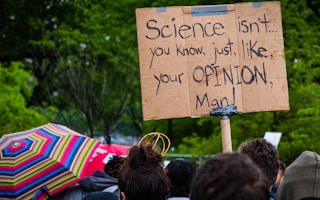Once upon a time there was an individual with powers so mighty he could have singlehandedly shaped the American climate movement into a permanent voice of world leadership.
For 25 years he offered communications advice to the science world. He was the best, but he was ignored. Fed up, he basically became the Darth Vader of the climate crisis. He drifted to the dark side, becoming a bonus for the early climate denial camp.
The individual was blockbuster techno-thriller author Michael Crichton. After earning an MD degree from Harvard in 1969 and working as a postdoctoral fellow at the Salk Institute, he moved to Hollywood. By 1995 he was the first person to ever simultaneously have the No. 1 book, No. 1 movie and No. 1 TV show in the U.S.
The climate story for Crichton begins in 1975 when, just before leaving the medical world, he published a short paper in the New England Journal of Medicine titled “Medical Obfuscation: Structure and Function.” His writing was concise and powerful, pointing out how the communication of science suffers from one key word: obfuscation, the practice of making things unclear or confusing.
The paper went largely ignored.
By the 1990s the issue of global warming was becoming more prominent. The nations of the world formed the Intergovernmental Panel on Climate Change (IPCC). Every few years the IPCC puts out a report on climate change, accompanied by a Summary for Policymakers, or SPM, intended to be the short, “easy-to-read” version of the report.
The concept is good, but the execution has been poor. In 2008, John Sterman, director of the Systems Dynamics Group in the MIT Sloan School of Management, reported on an experiment he conducted with 212 MIT graduate students where they summarized the basic message of the SPM from the latest report. When he checked their summaries, 84 per cent failed to grasp the science the way the SPM’s authors had intended.
Seven years later, Jeff Tollefson, U.S. correspondent for Nature, reported his use of the Flesch Reading Ease test to analyse SPMs going back to 1990. The trend was straight downhill — meaning the more information the IPCC gathered, the worse the communication.
In 1999, Crichton gave a keynote speech to the American Association for the Advancement of Science (AAAS) in which he warned of what we now call “fake news” and called for a single, agreed-upon voice of science authority. He presciently predicted, “The information society will be dominated by the groups and people who are most skilled at manipulating the media for their own ends.”
He recommended that science cultivate a single, widely recognized group of media-savvy spokespeople similar to those found in the worlds of “sports, politics, business, law and medicine.” He added, “I recognise that to build a pool of media stars is going to take a minor revolution in professional attitudes. But you have no choice.”
Members of the scientific community ignored Crichton. He wasn’t “a scientist” in their literal-minded perspective, and they weren’t interested in advice from outside their insular domain.
Crichton’s response? He stopped trying to help science. Instead, he became a climate science denier.
It’s now 2020, and obfuscation remains the bane of the climate movement. Crichton offered powerful expertise, but he was ignored — which is maybe not that surprising, given that people focused on a single mission often become single minded to the point of myopia. But now the climate stakes are so high we can’t afford to let this happen further.
“
It’s now 2020, and obfuscation remains the bane of the climate movement.
What’s the solution?
Sterman recommended in his 2008 report that climate scientists “partner with psychologists, sociologists, and other social scientists to communicate the science in ways that foster hope and action rather than denial and despair” — in other words, team up with other highly educated experts. That’s great advice if you’re seeking to analyse communication.
But actually doing communication is different. The former is intellectual, the latter is visceral.
In reality, what climate communication really needs is non-academics who have the communication thing nailed down — in other words, marketers and Hollywood types.
Two-time Pulitzer Prize winner Nicholas Kristof advocated a decade ago the idea of turning to the advertising world for communications advice in his great 2009 Outside Magazine article (which every environmental communication student should be required to read). I myself have spent decades pointing to the communications power and savvy of Hollywood.
The fight against obfuscation continues to get both more challenging and more important as we hurtle deeper into the “information society” that Crichton warned of in 1999. The public has increasingly lost its ability to process substance. More than ever, both the messenger and the medium matter.
So, are we doomed? Not yet, but we have to think creatively. Who would have thought that teenager Greta Thunberg would have more communications power than the entire rest of the climate community?
Michael Crichton wasn’t always the Darth Vader of climate. You can still read his 1999 AAAS keynote. You will see it is both free of climate skepticism and packed with advice that two decades later still provides the needed blueprint for the mass communication of science to the public. And we can still heed it.
Which means that just as Darth Vader redeemed himself in his final acts, the same could yet be possible for this giant of a man who departed as an enemy of the climate movement.
Randy Olson is a scientist-turned-filmmaker and narrative consultant. This article was originally published on Ensia.









